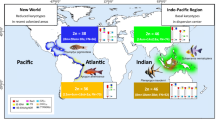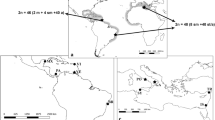Abstract
In the absence of fossils, the origin of Notothenioidei, a perciform suborder dominating the fish fauna of the Southern Ocean, remains conjectural; some morphoecological evidence suggests relationships to zoarcoids. To test this point we have compared the karyotype morphology and genome size of two species of zoarcids from the Ross Sea to those of one species each of the notothenioid families Artedidraconidae, Bathydraconidae, Channichthyidae and Nototheniidae from the same region. A karyotype of 48, mostly acrocentric, chromosomes, localization of nucleolar organizers on a pair of small dibrachial chromosomes, a genome size of about 3 pg of DNA, characterize both zoarcids; similar features can be found in the karyology of the notothenioids (especially the Nototheniidae). However, all shared characters appear as plesiomorphic in teleost karyology, which does not help in producing new data on the problem of notothenioid relationships.
Similar content being viewed by others
References
Anderson ME (1984) Zoarcidae: development and relationships. In: Moser HG, Richards WG, Cohen DM, Fahay MP, Kendall AW, Richardson SL (eds) Ontogeny and systematics of fishes. Am Soc Ichthyol Herpetol Spec Publ 1:578–582
Anderson ME (1990) The origin and evolution of the Antarctic Ichthiofauna. In: Gon O, Heemstra PC (eds) Fishes of the Southern Ocean. JLB Smith Inst Ichthyology, Grahamstown, South Africa, pp 28–33
Bogart JP (1990) Polyploidy in evolution of amphibians and reptiles. In: Lewis HE (ed) Polyploidy: biological relevance. Plenum Press, New York, pp 341–369
Bull JJ (1983) Evolution of sex determining mechanisms. Benjamin/ Cumming, Menlo Park, California
Cavalier-Smith T (1985) The evolution of genome size. Wiley, New York
Cheng CC, de Vries AL (1991) The role of antifreeze glycopeptides and peptides in the freeze avoidance of cold-water fish. In: Di Prisco G (ed) Life under extreme conditions: biochemical adaptation. Springer, Berlin Heidelberg, New York, pp 1–14
de Vries AL (1988) The role of antifreeze glycopeptides and peptides in the freezing avoidance of Antarctic fishes. Comp Biochem Physiol 908:611–621
Eakin RR (1981) Osteology and relationships of the fishes of the Antarctic family Harpagiferidae (Pisces, Notothenioidei). In: Kornicker LS (ed) Antarct Res Ser, vol 31. Biology of the Antarctic seas IX: 81–147. American Geophysical Union, Washington, DC
Eastman JT (1991) Evolution and diversification of Antarctic Notothenioid fishes. Am Zool 31:93–109
Eastman JT (1993) Antarctic fish biology. Academic Press, San Diego, California
Garrido-Ramos MA, Jamilena M, Lozano R, Cardenas S, Ruiz Rejon C, Ruiz Rejon M (1995) Cytogenetic analysis of gilthead seabreamSparus auratus (Pisces, Perciformes), a deletion affecting the NOR in hatchery stock. Cytogenet Cell Genet 68:3–7
Gold JR (1979) Cytogenetics. In: Hoar WS, Randall DJ, Brett JR (eds) Fish physiology. VIII. Bioenergetics and growth. Academic Press, New York, pp 353–405
Gold JR (1980) Chromosomal change and rectangular evolution in North American Cyprinid fishes. Genet Res 35:157–164
Gold JR, Amemiya CT (1987) Genome size variation in North American minnows (Cyprinidae). II. Variation among 20 species. Genome 29:481–489
Gon O, Heemstra PC (1990) Fishes of the Southern Ocean. JLB Smith Inst Ichthyology, Grahamstown, South Africa
Gosline WA (1968) The suborder of perciform fishes. Proc US Natl Mus 124:1–78
Grande L, Eastman JT (1986) A review of Antarctic ichthyofaunas in the light of new fossil discoveries. Palaeontology 29:113–137
Hinegardner R (1976) Evolution of genome size. In: Ayala F (ed) Molecular evolution. Sinauer, Sunderland, pp 179–199
Howell WM, Black DA (1980) Controlled silver-staining of nucleolar organizer regions with a protective colloidal developer: a 1-step method. Experientia 36:1014–1015
Iwami T (1985) Osteology and relationship of the family Channichthyidae. Mem Natl Inst Polar Res Tokyo Ser E 36:1–69
Levan A, Fredga K, Sandberg AA (1964) Nomenclature for centromeric position of chromosomes. Hereditas 52:201–220
Lin MS, Comings DE, Alfi OS (1977) Optical studies of the interactions of 4′-6-diamino-2-phenylindole with DNA and metaphase chromosomes. Chromosoma 60:15–25
Lozano R, Ruiz Rejon C, Ruiz Rejon M (1992) A comparative analysis of NORs in diploid and triploid salmonids: implications with respect to the diploidization process occurring in this fish group. Heredity 69:450–457
Miller RG (1993) A history and atlas of the fishes of the Antarctic Oceans. Foresta Institute, Carson City, Nevada
Mittwoch U (1973) Genetics of sex differentiation. Academic Press, New York
Morescalchi A (1992) Structural and molecular approaches to the phylogeny of Amphibia. Boll Zool 59:23–31
Morescalchi A (1994) Chromosomes, sex determination and environment in teleosteans. In: Dallai R (ed) Sex origin and evolution. Selected Symposia Monographs. Unione Zoologica Italiana, 6, Mucchi, Modena, pp 137–149
Morescalchi A, Pestarino M, Pisano E, Stanyon R, Stingo V, Morescalchi MA (1991) Preliminary data on the cytogenetics of Notothenioid fishes. In: Battaglia B, Bisol PM, Varotto M (eds) Proc First Meeting Biol Antarctica, Roma 1989, Martello, Milano, pp 201–213
Morescalchi A, Hureau JC, Olmo E, Ozouf-Costaz C, Pisano E, Stanyon R (1992a) A multiple sex-chromosome system in Antarctic ice-fishes. Polar Biol 11:655–661
Morescalchi A, Pisano E, Stanyon R, Morescalchi MA (1992b) Cytotaxonomy of Antarctic teleosts of thePagothenia/ Trematomus complex (Nototheniidae, Perciformes). Polar Biol 12:553–558
Ohno S (1970) Evolution by gene duplication. Alien & Unwin, London
Ohno S (1974) Animal cytogenetics, vol 4. Borntraeger, Berlin
Ojima Y (1983) Fish cytogenetics. In: Sharma AK, Sharma A (eds) Chromosome in evolution of eukaryotic groups, nol. CRC Press, Boca Raton, Fla, pp 111–145
Ozouf-Costaz C, Hureau JC, Beaunier M (1991) Chromosome studies on fish of the suborder Notothenioidei collected in the Weddell Sea during Epos 3 cruise. Cybium 15:271–289
Pedersen RA (1971) DNA content, ribosomal gene multiplicity and cell size in fish. J Expl Zool 177:65–78
Phillips RB, Pleyte KA, Hartley SE (1988) Stock-specific differences in the number and chromosomal positions of the nucleolar organizer regions in arctic charSalvelinus alpinus. Cytogenet Cell Genet 48:9–12
Prirodina VP (1986) Karyotypes ofCottoperca gobio (Bovichthyidae, Notothenioidei) as compared to the karyotypes of other Notothenioidei. Morphology and distribution of fishes of the Southern Ocean. Proc Zool Inst Leningrad 153:67–71
Purdom CE (1973) Induced polyploidy in plaice (Pleuronectes platessa) and its hybrid with the flounder (Platicthys flesus). Heredity 29:11–17
Schmid M (1982) Chromosome banding in Amphibia. VII. Analysis of the structure and variability of NORs in Anura. Chromosoma 87:327–344
Stingo V, Capriglione T, Rocco I, Improta R, Morescalchi A (1989) Genome size and A-T rich DNA in Selachians. Genetica 79:197–205
Thorgaard GH (1986) Ploidy manipulation and performance. Aquaculture 57:57–64
Young GC (1991) Fossil fishes from Antarctica. In: Tingey RJ (ed) The geology of Antarctica. Oxford University Press, Oxford, pp 538–567
Author information
Authors and Affiliations
Rights and permissions
About this article
Cite this article
Morescalchi, A., Morescalchi, M.A., Odierna, G. et al. Karyotype and genome size of zoarcids and notothenioids (Taleostei, Perciformes) from the Ross Sea: cytotaxonomic implications. Polar Biol 16, 559–564 (1996). https://doi.org/10.1007/BF02329052
Received:
Accepted:
Issue Date:
DOI: https://doi.org/10.1007/BF02329052




